 |
| Lena's final resting place catches the morning sun and is cool and shady in summer |
 | |
| small statue marking Lena's final resting place |
A BLOG ABOUT THE NATURE OF ROBERTSON, NSW, AUSTRALIA
ABOUT THINGS WHICH GROW HERE, NATURALLY; SOME OF MY SPECIAL INTERESTS - NATIVE PLANTS AND INSECTS, AND CULTIVARS OF PEONIES AND ROSES WHICH I GROW.
AND ABOUT LIFE IN ROBERTSON, TOO.

 |
| Lena's final resting place catches the morning sun and is cool and shady in summer |
 | |
| small statue marking Lena's final resting place |
 |
| Video to accompany "Birdland" and shown at Fed Square |
 Two flowers on a single stem give them their name.
Two flowers on a single stem give them their name. Today my daughter Zoe reminded me that it is Daffodil Day.
Today my daughter Zoe reminded me that it is Daffodil Day. Zoe brought with her a Cancer Council Teddy Bear which a good friend of ours, Sean Leane had given her - for Daffodil Day. Thanks Sean.
Zoe brought with her a Cancer Council Teddy Bear which a good friend of ours, Sean Leane had given her - for Daffodil Day. Thanks Sean.
 From the look in Lena's eyes, she had clearly indulged in too much "Green Fairy" at the After-Party.
From the look in Lena's eyes, she had clearly indulged in too much "Green Fairy" at the After-Party.
 Regular readers will note that this is the opposite view of the Illawarra Coastline and Escarpment, from that taken a few days ago, at Lees Road Lookout, near Knights Hill.
Regular readers will note that this is the opposite view of the Illawarra Coastline and Escarpment, from that taken a few days ago, at Lees Road Lookout, near Knights Hill. Stanwell Tops is famous for Lawrence Hargrave's early experiment with flight - below a train of four box kites on 12 November 1894. Hargrave was suspended on a line below the lowest Box Kite, and he was tethered to the ground by a line held by an assistant. He rose 16 feet in the air.
Stanwell Tops is famous for Lawrence Hargrave's early experiment with flight - below a train of four box kites on 12 November 1894. Hargrave was suspended on a line below the lowest Box Kite, and he was tethered to the ground by a line held by an assistant. He rose 16 feet in the air. Now this patch of the Illawarra Coast has another feature to boast about - the Sea Cliff Bridge.
Now this patch of the Illawarra Coast has another feature to boast about - the Sea Cliff Bridge. "The Sea Cliff Bridge, opened in 2005, restored the connection between Clifton and Coalcliff, broken by frequent rock falls onto this section of the Lawrence Hargrave Drive. The bridge lies parallel to the former "coal cliffs" and offers scenic views of the cliffs, the sea, and surrounding coastline."
"The Sea Cliff Bridge, opened in 2005, restored the connection between Clifton and Coalcliff, broken by frequent rock falls onto this section of the Lawrence Hargrave Drive. The bridge lies parallel to the former "coal cliffs" and offers scenic views of the cliffs, the sea, and surrounding coastline."
 You can see the cliffs from the free-standing bridge which is built on pylons which runs parallel to the coast. It was designed to overcome repeated blockages from landslips of the original road (the Lawrence Hargrave Drive)
You can see the cliffs from the free-standing bridge which is built on pylons which runs parallel to the coast. It was designed to overcome repeated blockages from landslips of the original road (the Lawrence Hargrave Drive) Clearly the RTA is very proud of this bridge.
Clearly the RTA is very proud of this bridge. At 9:08 pm (we are talking Australian Eastern Summer Time, or Daylight Saving Time), the sky had darkened, and the reflected light from the Earth had ceased bouncing back onto the moon. So, now we have the classic crescent of the New Moon. The colour of the illuminated edge of the moon (sun's light just visible on the merest arc of the Moon) had increased, as the Moon is now visible through a greater distance of the earth's atmosphere (as it is now lower than the first shot). That means more of the atmospheric pollution is now colouring the Moon.
At 9:08 pm (we are talking Australian Eastern Summer Time, or Daylight Saving Time), the sky had darkened, and the reflected light from the Earth had ceased bouncing back onto the moon. So, now we have the classic crescent of the New Moon. The colour of the illuminated edge of the moon (sun's light just visible on the merest arc of the Moon) had increased, as the Moon is now visible through a greater distance of the earth's atmosphere (as it is now lower than the first shot). That means more of the atmospheric pollution is now colouring the Moon. According to a Moon Chart I found (on a "Aus bush foods" website) the New Moon event occurred on 8 January. According to the purists, the New Moon is when the moon is present in the sky, but is not visible (when the far side of the moon is being lit by the sun) because we are seeing only the "dark side" of the moon. I am not a purist, and tend to regard the first illuminated sliver of the moon as being the "new moon". I am not alone, in counting it from that time. Wikipedia will explain all the subtleties of that debate for you.
According to a Moon Chart I found (on a "Aus bush foods" website) the New Moon event occurred on 8 January. According to the purists, the New Moon is when the moon is present in the sky, but is not visible (when the far side of the moon is being lit by the sun) because we are seeing only the "dark side" of the moon. I am not a purist, and tend to regard the first illuminated sliver of the moon as being the "new moon". I am not alone, in counting it from that time. Wikipedia will explain all the subtleties of that debate for you.
 (Photo by Peter Johnson)
(Photo by Peter Johnson) He has considerable technological assistance, but he knows how to get the best out of his equipment, too. He also is a good judge of his audience, for he played a few numbers which were popular with both Zoe and myself, including "Sultans of Swing" which had Zoe and me reminiscing on having attended a famously wet concert by "Dire Straights" and "Hothouse Flowers", at the Bruce Stadium in Canberra many, many years ago.
He has considerable technological assistance, but he knows how to get the best out of his equipment, too. He also is a good judge of his audience, for he played a few numbers which were popular with both Zoe and myself, including "Sultans of Swing" which had Zoe and me reminiscing on having attended a famously wet concert by "Dire Straights" and "Hothouse Flowers", at the Bruce Stadium in Canberra many, many years ago. Peter joined us for dinner, and a bit of a giggle. He was keen to take a photograph or two, and to re-live his moments as an assistant director on the shooting of Babe, in Robbo (also many years ago). Everyone had a few memories to re-live tonight, it seems.
Peter joined us for dinner, and a bit of a giggle. He was keen to take a photograph or two, and to re-live his moments as an assistant director on the shooting of Babe, in Robbo (also many years ago). Everyone had a few memories to re-live tonight, it seems. Tomorrow I shall be handing out "How to Vote" slips for the Climate Change Coalition. Patrice Newell and Dr Karl Kruszelnicki are both standing for the Senate in NSW. I have no idea how successful they will be, but I certainly feel determined to help them both in their campaign. And that is not the least because of the support which Patrice has shown the Save Water Alliance in our fight to protect the Kangaloon Aquifer. It turns out that protection of rivers, (and Aquifers) is a State wide battle, in the face of the onslaught of Coal Mining, both Open Cut mining, and the insidious "Longwall Mining", which although conducted very deep underground, can crack rivers, and even risk damaging roads and bridges (such as the Douglas Dark Twin Bridges), as discussed recently.
Tomorrow I shall be handing out "How to Vote" slips for the Climate Change Coalition. Patrice Newell and Dr Karl Kruszelnicki are both standing for the Senate in NSW. I have no idea how successful they will be, but I certainly feel determined to help them both in their campaign. And that is not the least because of the support which Patrice has shown the Save Water Alliance in our fight to protect the Kangaloon Aquifer. It turns out that protection of rivers, (and Aquifers) is a State wide battle, in the face of the onslaught of Coal Mining, both Open Cut mining, and the insidious "Longwall Mining", which although conducted very deep underground, can crack rivers, and even risk damaging roads and bridges (such as the Douglas Dark Twin Bridges), as discussed recently. Today Zoe asked me to remove a new Mud Wasp nest on her window, out on the front verandah. As this is Zoe's favourite sitting area, I agreed to remove the nests, before the wasps got too fond of going back to that spot, time and time again.
Today Zoe asked me to remove a new Mud Wasp nest on her window, out on the front verandah. As this is Zoe's favourite sitting area, I agreed to remove the nests, before the wasps got too fond of going back to that spot, time and time again.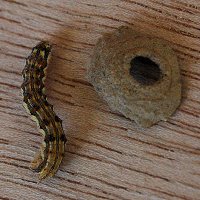
 This is what the wasps do, to provide food for their larvae. They sting their prey and semi-paralyse their victims, then lay an egg inside the nest.
This is what the wasps do, to provide food for their larvae. They sting their prey and semi-paralyse their victims, then lay an egg inside the nest. The last photo clearly shows the larva (or is it the developing egg) inside the remains of the nest, after I had broken it off the window.
The last photo clearly shows the larva (or is it the developing egg) inside the remains of the nest, after I had broken it off the window.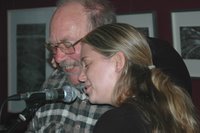 Last evening, Boney rang to invite Zoe and myself around for a glass of something. When I got there, I discovered that Zoe and Boney had hatched a plot.
Last evening, Boney rang to invite Zoe and myself around for a glass of something. When I got there, I discovered that Zoe and Boney had hatched a plot. After a straight week of heavy frosts, this morning was refreshingly mild.
After a straight week of heavy frosts, this morning was refreshingly mild.We swapped frosts for a light fog, last night.
The fog insulated us, during the night, like a comfort blanket, so that for the first time in a week, we did not have frozen soil, and a heavy frost.
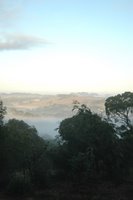 The fog over Robertson during the night, lifted early, and become a light cloud cover.
The fog over Robertson during the night, lifted early, and become a light cloud cover.
However, it left patches of fog in the local gullies, below the house.
Zoe was up earlier than I was (I did my patriotic duty, and watched the Socceroos play Brazil so I allowed myself a little sleep-in to compensate for the lost sleep).
Anyway, when Zoe first woke, there were nice patches of light fog down in the local gullies below our house, so she felt inspired to take some photos. These shots are all looking down over the road down to Belmore Falls, but they are local views, not distant views. It was good that she took these photos early, as the fog burnt off very quickly. You can see that in this photo, the fog is already very light and whispy. Lovely morning light, though. The green hills in the background are the next ridge across from the ridge where I live. It is the hillside that Pearson's Lane runs along.
It was good that she took these photos early, as the fog burnt off very quickly. You can see that in this photo, the fog is already very light and whispy. Lovely morning light, though. The green hills in the background are the next ridge across from the ridge where I live. It is the hillside that Pearson's Lane runs along.
*****
8:45 pm: Being true to my word, here are the photos. Sorry it took so long to put them up.
 I moved to Robertson from Canberra, where, undoubtedly it is colder than Robertson. However, there is something different about the "cold" in Robertson. It is a wetter place, and so the cold seems to penetrate more.
I moved to Robertson from Canberra, where, undoubtedly it is colder than Robertson. However, there is something different about the "cold" in Robertson. It is a wetter place, and so the cold seems to penetrate more.
Two days ago, we had a lot of rain during the day, then the clouds cleared off in the late afternoon. I know that always means trouble. For example, I was alert to the possibility of black ice on the road, the next morning.
What I had not anticipated was that the heater would run out of gas at 4:00am, and that Zoe, (the great softie that she is) would decline to go out and turn the switch from one gas bottle to the other - 30 seconds work. I was persuaded to go out and do the job myself, by Zoe thumping around the house, trying to get warm - a futile exercise, on such a cold night. Indeed it was the hot water running out when she tried to run a hot bath in order to warm up, which really triggered my decision to turn the gas tap over myself. Incidentally, I have an electric blanket, but until tomorrow's scheduled visit to Bowral, Zoe does not - she just has a cat to keep her warm. She has been promised an electric blanket, though. The cat will be ecstatic!
Anyway, I went outside, to find the switch for the gas tank, only to be surprised by hearing myself crunching over the grass (weeds, really). Odd, I thought - must be a heavy frost to do that. Next morning, I discovered that the source of the sound effects was that I had been crushing thousands of ice crystals, under the soil, as I walked just a few paces to the gas bottle.
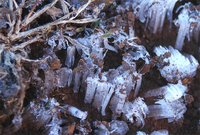 Technically, these crystals which form in the soil are known as "permafrost", but my Northern Hemisphere friends will scoff at the application of that term to this little bit of ice formation, for it is not "permanent", or even semi-permanent. We aren't on the Arctic Tundra here. But what I was experiencing is quite different from a normal frost, where tiny particles of dew freeze on the surface of the grass, or soil. This was moisture in the soil freezing slowly, and, as a result, the crystals growing up out of the soil, and they lift the surface of the soil up to the height of the crystals, about 3 or 4 cms high. These crystals have great lifting power, and tiny pebbles, and small rocks will be lifted as the crystals beneath them form. Such crystals can, indeed crack large rocks, if they form within crevices in the rock, then expand.
Technically, these crystals which form in the soil are known as "permafrost", but my Northern Hemisphere friends will scoff at the application of that term to this little bit of ice formation, for it is not "permanent", or even semi-permanent. We aren't on the Arctic Tundra here. But what I was experiencing is quite different from a normal frost, where tiny particles of dew freeze on the surface of the grass, or soil. This was moisture in the soil freezing slowly, and, as a result, the crystals growing up out of the soil, and they lift the surface of the soil up to the height of the crystals, about 3 or 4 cms high. These crystals have great lifting power, and tiny pebbles, and small rocks will be lifted as the crystals beneath them form. Such crystals can, indeed crack large rocks, if they form within crevices in the rock, then expand.
Leo and Anni are entitled to tell me that I don't know anything about real cold. But it is cold enough for me, here in Robertson. It is also cold enough for Peonies, which was my primary criterion, when selecting a location when I moved from Canberra.
 I mentioned last Wednesday the "Optimistic Nature of the Tree Dahlia". Great timing for that post. Have a look at it, on the morning of our big freeze. That was yesterday. Today it is showing even more damage, but you get the point - its growing season is over - for this year.
I mentioned last Wednesday the "Optimistic Nature of the Tree Dahlia". Great timing for that post. Have a look at it, on the morning of our big freeze. That was yesterday. Today it is showing even more damage, but you get the point - its growing season is over - for this year.
Oh well, it will have to start again next year to grow two metres tall, or more, before it will start to form its flowers, in late April or May. And, of course, it is destined never to set any seed, in Robertson. Poor thing. But I love the way it keeps on trying.
One could say that it is a metaphor for someone being treated for Lymphoma, really! No wonder I admire its stubborn hold on life.
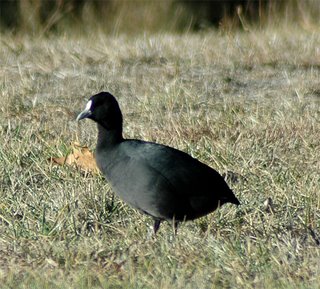 Yesterday I posted about Purple Swamp Hens (Galinules). I commented that the associated bird, the Eurasian Coot was "totally aquatic". Ooops. Today I went to Lake Tuggeranong, to be confronted by a bunch of Coots out grazing. Admittedly, as soon as they saw me, they headed to the water, where, clearly they felt more comfortable. However, I feel obliged to set the record straight. They also graze on dry grass, near water, as in this photo.
Yesterday I posted about Purple Swamp Hens (Galinules). I commented that the associated bird, the Eurasian Coot was "totally aquatic". Ooops. Today I went to Lake Tuggeranong, to be confronted by a bunch of Coots out grazing. Admittedly, as soon as they saw me, they headed to the water, where, clearly they felt more comfortable. However, I feel obliged to set the record straight. They also graze on dry grass, near water, as in this photo.
In the main cities of South-eastern Australia, there are 3 basically similar birds which are common wherever lakes and parks are found. (I am excluding Ducks, etc.) These are either aquatic birds which gather near picnic grounds, or birds with longish legs which hang around on the grass, looking for scraps from picnickers. Simply put, these birds are most likely to be Swamp Hens, Moor Hens, and Coots. Today I will deal mostly with the Moor Hen (and the others just in comparison). There are other, more exotic birds, called Black-tailed Native Hens, and in Tasmania, another species. But these three species are the most commonly seen, between Brisbane and Melbourne. Other related birds are Crakes and Rails, but they are usually very shy, and seldom seen. None of these birds under discussion is shy - far from it.
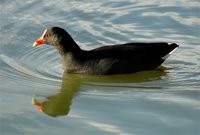 The Dusky Moorhen is the third bird in this group, which people often get confused about. This bird has a red beak, with a yellow tip, (as an adult). In general, its beak is like the Swamp Hen's, (but much finer). This bird is quite at home in the water (like a Coot). In size, it is slightly larger than the Coot, and only about half the size of the Swamp Hen. So, the main differences between them are (a) size (Swamp Hen clearly the largest); (b) preference for water over land 1 - Coot, 2 - Moor Hen, and coming a bad last - Swamp Hen.
The Dusky Moorhen is the third bird in this group, which people often get confused about. This bird has a red beak, with a yellow tip, (as an adult). In general, its beak is like the Swamp Hen's, (but much finer). This bird is quite at home in the water (like a Coot). In size, it is slightly larger than the Coot, and only about half the size of the Swamp Hen. So, the main differences between them are (a) size (Swamp Hen clearly the largest); (b) preference for water over land 1 - Coot, 2 - Moor Hen, and coming a bad last - Swamp Hen.
 So, of these 3 birds, if it is swimming freely and cheerfully, it is a Coot or a Moor Hen. (Check photo at left). If so, look for a red beak and head shield (Moor Hen), or silvery white, (Coot). Clearly, the bird on the left is a Coot, the other a Moor Hen.
So, of these 3 birds, if it is swimming freely and cheerfully, it is a Coot or a Moor Hen. (Check photo at left). If so, look for a red beak and head shield (Moor Hen), or silvery white, (Coot). Clearly, the bird on the left is a Coot, the other a Moor Hen.
If it is walking about amongst the reeds, it is likely to be, in order, 1 - Swamp Hen, 2 Moor Hen (distinguish them by size) 3 Coot (they do nest in reeds - look for the silver colour of the beak and head shield).
There is another more subtle clue - the shape of the tail and wings. Coots look as if they have rounded backs and their tails are not prominent. They fade off into the water. That "rounded back" look is apparent, even in the photo of the bird on land. The Moor Hen has a prominent, upward-tilted tail and its wings follow that line. So, its tail comes to a point, held high above the water. That is always helpful, in case you find an immature Moor Hen, which has a dark olive green beak, with maybe a touch of red just showing. Look at the wings and tail. It is immediately distinctive between these two species which swim freely. If its tail is pointed diagonally up, at about 30 degrees. and it shows a flash of white underneath, it is a Dusky Moorhen.
 Finally, the Swamp Hen is a very active bird, on land. When it runs (as it does very well) it typically flicks its tail, showing a bold "alarm signal" patch of white feathers under its tail. This is totally distinctive. So even if you just get a poor, rear view of a large swamp bird, but it was flicking its tail, then you know it was a Swamp Hen. This particular bird ran away from me (sorry the photo is blurry), but it took with it a juicy piece of grass to chew on, when it was safely distant from me.
Finally, the Swamp Hen is a very active bird, on land. When it runs (as it does very well) it typically flicks its tail, showing a bold "alarm signal" patch of white feathers under its tail. This is totally distinctive. So even if you just get a poor, rear view of a large swamp bird, but it was flicking its tail, then you know it was a Swamp Hen. This particular bird ran away from me (sorry the photo is blurry), but it took with it a juicy piece of grass to chew on, when it was safely distant from me.
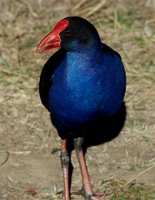 The other day, Zoe and I took my father out for a drive, and we ended up at the Lake (Lake Burley Griffin). There were a few, very hungry Swamp Hens (Purple Galinules)(Porphyrio porphyrio) around. Dad and I sat in the car, and watched these birds from close quarters, (birdwatching for the aged and the frail), while Zoe got out and took a few photos.
The other day, Zoe and I took my father out for a drive, and we ended up at the Lake (Lake Burley Griffin). There were a few, very hungry Swamp Hens (Purple Galinules)(Porphyrio porphyrio) around. Dad and I sat in the car, and watched these birds from close quarters, (birdwatching for the aged and the frail), while Zoe got out and took a few photos.
These birds are swamp-edge dwellers, normally, but they have had such a poor season that they have taken to digging up the nearly dry bulbous "crowns" of Kikuyu Grass, to eat. This is on the dry grassed areas surrounding the Lake. Slim pickings, indeed. Normally they pull up moist roots of swamp plants, reeds, etc.
"Swamp Hen Feeding"
 They are particularly well adapted to this manner of feeding, with their huge, powerful beaks (with a head-piece extension, which looks like a shield over the top of the head).
They are particularly well adapted to this manner of feeding, with their huge, powerful beaks (with a head-piece extension, which looks like a shield over the top of the head).
They hold the roots they are going to eat, under the foot, held there by the outer toe supporting the root, which is tucked up by the toes being slightly curled to hold it up along the "ankle" of the foot. My description is not good biology, but if you look a the picture, you will get the idea. The root is squeezed between the upper parts of the toes, not "grasped" in the way that a parrot grasps its food. Of course, their extremely long toes are designed primarily for spreading their weight over a large area, as they walk over water weeds, etc. So their feet are not suited to grasping, but are great for spanning a thin bunch of reeds, and floating water plants.
"Eurasian Coot"
 Zoe also had a chance to photograph the totally aquatic Eurasian Coot, (Fulica atra) which feeds by diving for water-weeds, which they bring to the surface, then eat, in small portions. On close examination of the photo at left (click for a larger image), you can see that the Coot has lobed toes, not a complete webbed foot (check the left foot), as a Duck has. But they are good swimmers and divers, none-the-less. Of course, their white beaks (with small head shields) are distinctive.
Zoe also had a chance to photograph the totally aquatic Eurasian Coot, (Fulica atra) which feeds by diving for water-weeds, which they bring to the surface, then eat, in small portions. On close examination of the photo at left (click for a larger image), you can see that the Coot has lobed toes, not a complete webbed foot (check the left foot), as a Duck has. But they are good swimmers and divers, none-the-less. Of course, their white beaks (with small head shields) are distinctive.
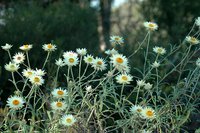 When Zoe and I went to the Botanic Gardens yesterday, I was scootering along the Main Path, when Zoe suddenly said: "Oh, look, - Grandma Flowers". And she was right.
When Zoe and I went to the Botanic Gardens yesterday, I was scootering along the Main Path, when Zoe suddenly said: "Oh, look, - Grandma Flowers". And she was right.
We had come to an area where Everlasting Daisies were growing everywhere. My Mother, Zoe's Grandma, was an inveterate collector of dried flowers, for use in dried flower arrangements, and the Everlasting Daisies were her absolute favourites. The Garage was full of unused specimens, the house was full of little wall vases always with a few Everlastings in them.
 Zoe remembers staying there on weekends, as a kid, and "helping" Grandma with her flower arrangements, which usually meant Zoe poking holes with her little fingers in the seemingly magic "Oasis" material which flower arrangers use. This stuff has a spongy texture, and, when dry it is nearly weightlessness. Of course, what Zoe didn't understand at the time, was that Oasis has its limits, and after enough poking with little fingers, it crumbles to a messy dust.
Zoe remembers staying there on weekends, as a kid, and "helping" Grandma with her flower arrangements, which usually meant Zoe poking holes with her little fingers in the seemingly magic "Oasis" material which flower arrangers use. This stuff has a spongy texture, and, when dry it is nearly weightlessness. Of course, what Zoe didn't understand at the time, was that Oasis has its limits, and after enough poking with little fingers, it crumbles to a messy dust.
 Still, Zoe loves these flowers, and to her they will always be "Grandma Flowers". So, they are a kind of Everlasting Memory for her. And I am pleased. My Mother, Nonie Wilson died on 18 March 2006, just a few days short of her 90th birthday. So this blog is for Zoe and for her.
Still, Zoe loves these flowers, and to her they will always be "Grandma Flowers". So, they are a kind of Everlasting Memory for her. And I am pleased. My Mother, Nonie Wilson died on 18 March 2006, just a few days short of her 90th birthday. So this blog is for Zoe and for her.
 This photo is here to prove that one cannot always take good photos of eagles, even with a fairly long lens. This bird spotted me, (and they have far, far better eyes than we do, so that is not surprising) and it decided that I was acting suspiciously, so it simply half-closed its wings, and went into a "semi-dive" mode, and drifted across the sky and away from me, at about 35 Km per hour (without even a single flap of its wings), until it felt comfortably distant from me again, a which point it resumed singing the chorus from "Oklahoma" about making "lazy circles in the sky".
This photo is here to prove that one cannot always take good photos of eagles, even with a fairly long lens. This bird spotted me, (and they have far, far better eyes than we do, so that is not surprising) and it decided that I was acting suspiciously, so it simply half-closed its wings, and went into a "semi-dive" mode, and drifted across the sky and away from me, at about 35 Km per hour (without even a single flap of its wings), until it felt comfortably distant from me again, a which point it resumed singing the chorus from "Oklahoma" about making "lazy circles in the sky".
For those of you who do not know, this is a Wedge-tailed Eagle, perhaps the Australian bird with the best Latin Name ever: Aquila audax, which means "bold eagle" (not bAld, bOld, as in daring). The word audacious comes from the same origin.
This photo was taken last weekend, on the same day as I went with Zoe to Tidbinbilla. This was taken near Tharwa, in fact at "Lambrigg" which is where William Farrer did his pioneering research into breeding rust-resistent strains of wheat, which led to the development of the Australian Wheat industry. What John Howard and the mob of conservative free-loading privateers have done since, with the AWB, is not his fault, folks.
Miss Eagle is celebrating her ability to soar over the ridges of Upper Ferntree Gully, tomorrow. Have a nice day, Girl. Fly Free.
Anni wondered what they do all day. In a word, they rest. Most of the "mob" will be females, and all the mature ones will all be pregnant, or carrying a "Joey", or have a "Joey" at foot, as in the second photo. Some may be in all three stages of motherhood at once.
The other thing about such a "mob" of Kangaroos is that they feed in the early evening and early morning, when the grass is most likely to have some dew on it, allowing them to drink and feed at the same time. During the day, the "mob" usually rest under a stand of trees, where they can get some shelter from the sun.
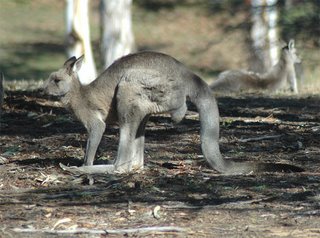 Zoe was quite pleased to get a photo of the male taking his weight on his tail, just about to propel himself across the ground at ultra-slow speed, using the tail as a "prop" while sliding his huge back feet forward.
Zoe was quite pleased to get a photo of the male taking his weight on his tail, just about to propel himself across the ground at ultra-slow speed, using the tail as a "prop" while sliding his huge back feet forward.
 She was even more pleased to get a photo of a grown Joey having a bit off a feed from Mum, even though she is nearly as large as Mum is.
She was even more pleased to get a photo of a grown Joey having a bit off a feed from Mum, even though she is nearly as large as Mum is.
CSIRO biologists have studied the amazing fertility of Kangaroos, and one fact they have discovered is that the female (a "doe") can simultaneously produce milk at different stages (from different teats) to suit the developmental needs of an "independent" Joey, like this one, and a smaller one which is almost certainly a permament resident of the pouch.